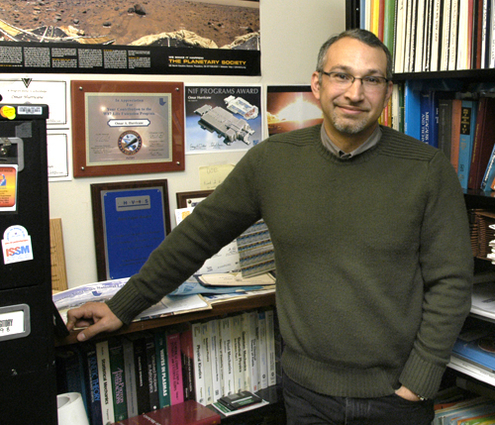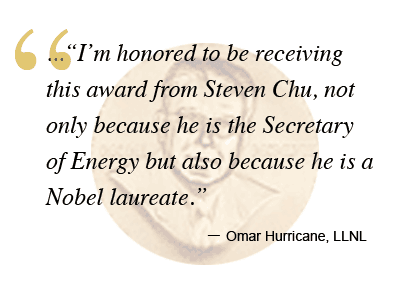Omar Hurricane wins E.O. Lawrence Award
Lab physicist Omar Hurricane was working at his computer, drinking another cup of coffee, awaiting a call from Secretary of Energy Steven Chu. Hurricane had briefed Chu a few months before, and thought the call was going to be about the briefing.
But the call was about something completely different.
"This is Secretary Chu, calling to congratulate you," was the way it started, recalls Hurricane.
What followed was a 15-minute conversation, during which Hurricane learned he was to receive the prestigious 2009 Ernest Orlando Lawrence Award in the field of national security and non-proliferation.
The award honors mid-career scientists and engineers for exceptional contributions in research and development supporting the Department of Energy and its mission to advance the national, economic and energy security of the U.S.
Hurricane says Chu then asked him to describe the work that led LLNL officials to nominate him for the award.
"Unfortunately, Mr. Secretary," said Hurricane, laughing, "I can't talk about it on the phone right now because it's classified." (Chu was briefed on the subject in person at a later date.)
Hurricane, who is a program element leader dealing in thermonuclear secondary design in the Weapons and Complex Integration (WCI) directorate, can only say that he led a multi-disciplinary team that worked on a difficult technical issue involving two vastly different areas of physics. "We were able to sort out the issues and form a solution," he says.
Lab Director George Miller nominated Hurricane for the award, having dealt with the same effort years earlier.
"I personally worked on aspects of this problem as a weapon designer nearly 30 years ago and initiated technical efforts to resolve this anomaly when I was the thermonuclear design leader. For years, the search for a physics-based model has failed due to the complexity of the physics. As a weapon designer and the project leader for several U.S. stockpile systems in the 1980s, I am very aware of the tremendous technical challenge and difficulty associated with this anomaly," wrote Miller.
Further praise came from WCI Principal Associate Director Bruce Goodwin, who added: "Dr. Hurricane's efforts resulted in the development of a consistent, science-based understanding and implemented a physics-based predictive model to simulate warhead performance across a wide range of stockpile regimes."
"I'm honored to be receiving this award from Steven Chu," says Hurricane, "not only because he is the Secretary of Energy but also because he is a Nobel laureate."
Hurricane is quick to point out that many people contributed to the project over the past decade. They not only needed to identify and understand the key physical processes involved, but then had to build computational tools to make predictions about the physics, and finally conduct experiments to validate their theories.
He compared the process to understanding gravity.
Realizing that gravity is what holds planets in their orbits is a step forward that directs your thinking. The second step is to build the mathematical models that predict how planets orbit the sun. Checking the mathematical models against observation is the final step. All three steps are important and are required to say that you understand and have solved the problem.
Hurricane, 41, came to LLNL 11 years ago from UCLA.
His previous honors include an individual Defense Programs Award of Excellence in 2004 from the National Nuclear Security Administration (NNSA). As a member of the larger team for a specific program element, he also shared an NNSA 2002 Defense Programs Award of Excellence.
The Lawrence Award comes with a citation signed by the Secretary of Energy, a gold medal bearing the likeness of Ernest Orlando Lawrence, and $50,000.






